|
Ampeer Paper Subscriber Reminder
When subscribing to or renewing the paper version of the Ampeer, please make the check payable to Ken Myers. We do not have a DBA for the Ampeer or EFO. Thanks, Ken
Porterfield Collegiate For Sale
Complete except for Speed control and receiver battery.
Includes Astro Flight 25G, 7ch Transmitter & receiver
Covered with Micafilm and finished with dope
Asking $100
Richard Fleming
408 Cottage St.
Olivet, MI 49076
269-749-9024
The Saga of the E-flite T-34 Mentor 25 ePTS RTF Continued
By Ken Myers
As I mentioned in October 2008 issue of the Ampeer, one of my flight students has this plane. He decided that he wanted to use the 2300mAh cells from A123 Systems, Inc.
I brought the plane home to build him a pack. It was the first time that I had spent a lot of time with this plane, besides at the field, trying to fly it.
The first thing that I discovered was that the bottom two bolts from the motor mount were protruding into the battery compartment. They protruded into the battery compartment about 5/32". In the event of an unanticipated arrival (crash), folks using Li-Pos might have wished they had looked before they crashed and punched in their battery with a protruding bolt! A few minutes with a cutoff wheel and grinder shortened the offending screws.
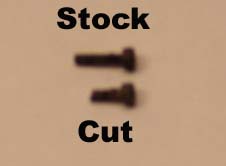
Next, I made an adapter for the power leads of the E-flite 40-Amp Pro Switch-Mode BEC Brushless ESC so that Anderson Power Poles (APP) and the original connector provided by E-flite could both be used.
I also mounted the electronic speed control (ESC) switch on the outside of the fuselage so that it wasn't just dangling inside the airframe. It is quite a bother when they provide a switch but no faceplate and screws!

The next task in converting to a 4S1P "A123" pack was to get the correct center of gravity (CG). We had added 3.67 oz./104g of lead stick-on weights to the top of the motor mount box, and the plane was flying "sort of okay", but I wanted to try and get the lead out by using the heavier cells and knowing the correct center of gravity (CG). The supplied 3200mAh Li-Po pack weighs 8.78 oz./249.05g and the new "A123" pack 11.34 oz./321.5g.
I drew half the wing plan form onto some paper and calculated the CG. Using the mean aerodynamic chord (MAC) I found the CG to be between 4" and 4 3/8" back from where the front of the wing leading edge protrusion seats in the wing saddle. The provided manual says that the CG is 4 3/4" to 4 7/8" from that point. No wonder that on the first flight of this plane it went up like a rocket. It wasn't just that the flaps were in the fixed down position. (To read about the initial flights and problems with this plane, see www.theampeeer.org/t34/t34.htm or the October 2008 Ampeer.)
Once I knew the CG that I wanted to use, I could then decide on the configuration of the 4S1P "A123" pack for this application. Wanting as much weight forward as possible, I chose a 4S1P side-by-side.
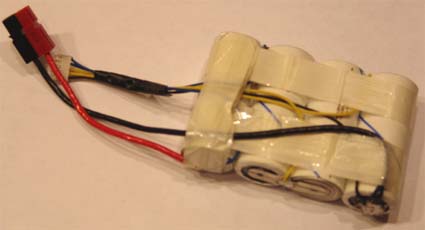
The "A123" pack uses VelcroTM on the bottom of the rear cell and a balsa wedge to hold it in place. There is very little room in the battery area for the cells to move side to side. That means it is a TIGHT fit!
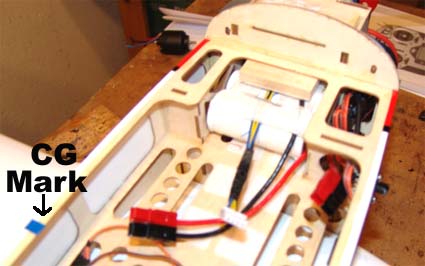
Drive Calculator (www.drivecalc.de) did not have the supplied E-flite Power 25 BL Outrunner Motor, 870Kv motor in its database (I've since added it), but I used another typical outrunner of about the same weight and Kv that E-flite says the 25 has to estimate what prop I might want to use. It looked like an APC 12x7 sport could work with the supplied 40-amp ESC, especially if I lowered the timing of the electronic speed control (ESC).
I mounted an APC 12x7 sport prop and then balanced the plane. The plane balanced just slightly back of the 4 3/8" point, so I had gotten the lead out and the CG about where I wanted it. Unfortunately, the APC 12x7 sport prop that I had on hand had already been reamed to 8mm, so I had to purchase a new prop before I could test the power system using that prop.
While it doesn't sound like I did much, it took a full day, 9 to 5, to get the plane to this point.
The next day I went to the local hobby shop and picked up an APC 12x7 sport prop and an APC 12x8E prop. I already had a new APC 12x6E, which is the prop that Jon and I are using on his E-flite Cub with the same power system.
After I returned home, I balanced the three APC props and the supplied E-flite 12x8 prop. I was very surprised to find that the supplied prop was the most out of balance of all four of the props. It has usually been my experience that APC props are more "out of balance" than other brands.
I changed the timing to the lowest possible (timing.htm) and the low voltage cutoff (LVC) to allow for the "A123" pack's lower LVC on the provided ESC. I found that the lowest timing available was 5-degrees and lowest LVC setting was 70% of the starting voltage. After downloading and reading the directions for the E-Flite 40-amp Pro, it took a while to catch on to the fact the E-flite 40-amp Pro uses the center throttle position as the "menu" and full on throttle position as the selection control. Changing the LVC proved challenging as the selection starts at 3 tones for a 3S Li-Po and continues through 6 tones for a 6S Li-Po. It was supposed to be 7 tones for the 70% cutoff, but it played a "jingle", not 7 straight tones. Maybe it was 7 tones, but it was very hard to tell, but I believe that I got it. There is no confirmation of the LVC setting when the ESC is activated. We have not experienced any premature cutoff to date.
I did not want to remove the motor from the airframe, so I did not do my usual drill press test to find the Kv. To test the motor, I did my usual 5 captures of data on my Emeter and used the averages to put into Drive Calculator to create the motor data that is now available in Drive Calculator.
Some Things to Keep in Mind When Looking at My Data, or Anyone Else's Data
1.) When using brushless motor systems, the motor and ESC used cannot be separated for efficiency claims. The specific ESC and selected timing is part of the motor.
2.) The ESC brand, amp rating and timing all affect the outcome of the observed and recorded results.
3.) The altitude of the static test site, ambient temperature and other local weather conditions affect the results.
4.) Props vary. APC has changed their props over time and not noted it to the end user.
The bottom line is that your results WILL vary.
This motor was static tested on a sunny day with the ambient temperature being about 70-deg F/21-deg C. The elevation here is about 980 ft./298m above sea level. The ESC was the supplied E-flite 40-Amp Pro Switch-Mode BEC Brushless ESC was set to a 5-deg advance. (The standard timing is 15-deg.) The numbers presented here are averages for five captures approximately 5 seconds apart.
No Load 1: 9.924v, 2.09 amps, 8688 RPM
No Load 2: 12.512v, 2.516 amps, 11022 RPM
E-flite 12x8: 10.646v, 37.002 amps, 7302 RPM
(Used fully charged 3S1P 3200mAh 15C supplied Li-Po)
APC 12x7 sport: 11.218v, 35.558 amps, 7878 RPM
(Used fully charged 4S1P 2300mAh "A123" pack)
E-flite 12x8: 393.97 watts in, ~73% sys. eff., Pitch Speed ~ 55.3 mph, 73.4 watts in/lb.
APC 12x7 sport: 399.23 watts in, ~74.5% sys. eff., Pitch Speed ~52.2 mph, 74.6 watts in/lb.
The following day I did the weights and measures and came up with the following information.
Wing area (without droops): ~555 sq.in.
RTF weight (w/supplied Li-Po): 85.88 oz./5.37 lb.
RTF weight (w/4S1P "A123"): 85.65 oz./5.35 lb.
CWL (w/supplied Li-Po): 11.32 oz./cu.ft. (typically advanced sport)
CWL (w/ w/4S1P "A123"): 11.29 oz./cu.ft. (typically advanced sport)
Wing Loading (w/supplied Li-Po): 22.24 oz./sq.ft.
Wing Loading (w/ w/4S1P "A123"): 22.18 oz./sq.ft.
The weights and power are just about equivalent and produce a stall speed of about 17.5 mph and a pitch speed to stall speed ratio of about 3 to 1.
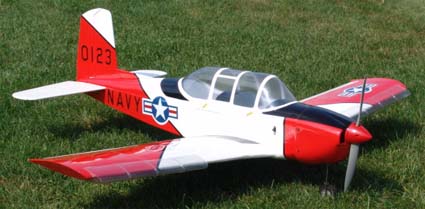
Chuck's T-34
Some Final Thoughts
From the threads on RC Groups about this plane, it seems that most of the folks purchasing this plane are not using it as a trainer.
If I were to purchase it for sport scale use, then I would most likely use the Scorpion S-4020-12 power system that I reviewed last month.
Using the noted power system would increase the RTF weight to about 103.3 oz./6.46 lb. The CWL would be increased to about 13.65 oz./cu.ft., which is still typically advanced sport. According to my data for the Scorpion motor from last month, a 6S "A123" pack would provide a little over the following for an APC 14x8.5E; 16.65v, 38.3 amps, 7500 RPM, 638 watts in. The watts in per pound would then be 98.76, with a pitch speed of 60 mph. The stall speed would increase to about 19.2 mph, still giving it about a 3:1 pitch speed to stall speed ratio, but with the larger, more efficient, diameter prop, the vertical maneuvers would increase in size and duration.
Return to "What's In This Issue"
A New parkzone T-28 "Problem"
By Ken Myers
I've had problems with the prop adapter since I first purchased this plane. The original adapter had the setscrew hole drilled at an angle and the threads were stripped. My original fix was to re-tap the setscrew hole for a 4-40 setscrew. That worked for a while, but the threads stripped on it as well. After several field fixes I decided to purchase a new prop adapter. On September 29, I purchased a prop adapter labeled "PKZ 1011 - NYA Prop Adapter: T-28".
Several surprises awaited me when I affixed this adapter to the parkzone 480 motor. First, my 11x8 Master Airscrew standard wood prop reamed to 8mm slide right on the prop adapter. That was good because the original adapter was over 8mm and had to be filed down to use with an 8mm hole.
Unfortunately, with the prop on the new adapter, it became clear that this adapter was much, much shorter than the original.
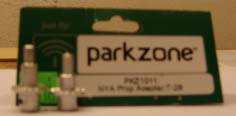
Original on the left, "new" on the right
The unthreaded part of the original adapter is 10mm long and the threaded part 9mm for a total of 19mm. The unthreaded part of the new adapter is only 6mm long and the threaded part 10mm for a total of 16mm. I sure could have used that extra 3mm.
It appears that parkzone/Horizon Hobby has another "quality control" issue for you to be aware of. The new prop adapter should present no problem to those using the supplied prop, but it caused me a problem when using my selected prop because of the thickness of the prop hub.
Return to "What's In This Issue"
Fury, Spitfire and Bearcat
From Keith Shaw Ann Arbor, MI
Hi Ken,
From the subject line it sounds like a lineup at Reno. Not really, but I thought I'd give you an update on a couple of projects. I decided to devote this summer to renovation/updating/tweaking several projects so at least something good comes out of my inability to travel to my usual long list of air shows and fly-ins. It is a way to keep my mind focused on the good and not let frustration get the better of me.
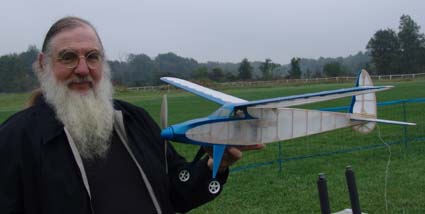
I think I showed you my drawings for the Phantom Fury, the enlarged replica of my first built-up rubber model (I was about 6 if I remember correctly). The original was by Comet Models with a 32" span. Mine is a 150% enlargement, with as little modification as possible to make it e-R/C. I made a wire landing gear (instead of wood!), added a bit of structure for hinging the tail surfaces and mounting the radio, and used a Clark Y instead of the weird sorta-Eiffel airfoil shown on the plans. BTW, I still had the original faded crumbling plan that I enlarged on a copy machine. Span is 48", area 220 sq.in, weight 11 oz, using a Berg receiver, HS-50 servos, an early Castle 10-amp controller, a tiny Scorpion outrunner, 2-cell Li-Po, and an APC 9x6SF prop. I test flew it this morning, and was overwhelmed with waves of nostalgia, as it brought back distant memories of the original circling in an abandoned parking lot in Cleveland where I grew up.
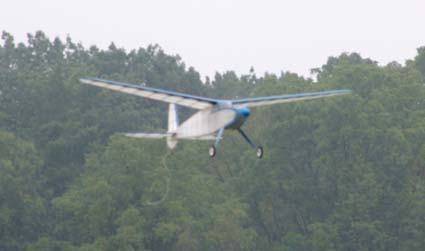
That is not the "mists of time" in the photo. It is real fog.
It effortlessly circles, catches even the slightest thermal, and looks great in the air. Even quarter throttle produced a mild climb! I had forgottrn to program in the brake, so the prop freewheeled in the glide, looking even more authentic.
I spent some time tweaking the Stomo and the Flashback, trying different props, CG, and minor trimming. Both are flying even better than ever now.
I really enjoy flying my ancient (1982) Spitfire, but the one irritating thing has been the small 270-mAh receiver NiCad pack that ALWAYS seemed to be dead or contain a marginal cell. I decided it was time to update it, so I am in the process of fitting a Castle 10-amp switching BEC. When I modified the plane for A123 cells, I was going between a 6-cell or 7-cell "A123" pack with prop changes to try to get it right. The problem is that the old brushed Astro cobalt 40g was basically loafing on either setup. Originally the Spitfire flew on an Astro cobalt 25g on 12 cells, the maximum number I could charge with my early homemade charger. I had to hand carve an 11x10 prop to get it to fly, and it was still pretty marginal. Once I had my 18-cell charger working it was converted to the 40g that is still in it. To make a long story short(er), I've decided to "retro" the plane back to the 25g and run it on 5 cells. That should be just about perfect on a 12x8. During the process I am redoing the entire power harness, arming switch and charge jack. All have served loyally, but the old wire is stiff (before the days of silicone insulation), the switch arm wobbles, and the charge jack was one I pulled out of an old transmitter. I look forward to just picking up the Spitfire on a whim and taking it out to the field.
On to the Bearcat. I stopped flying it two years ago as the covering is getting scratched and brittle, but everything else was fine other than the old dying NiCad power pack. I had planned on stripping and recovering it this fall, along with upgrading the power system. One of the sad points this year has been not being able to fly my CzechMate, as it takes a long runway and a LOT of airspace, and is just not suitable for my club's small field. It pains me to think of that "very" expensive 10S Li-Po sitting idle.
Originally I had planned on making an "A123" pack for the Bearcat, along with upgrading to an Astro brushless 60 from the original Astro FAI 60. The new 60 has the same bolt pattern and diameter as the old motor, so it should be a drop-in for the big MAT belt-drive. I'm sure I will have to change the drive ratio, but I have a handful of the small pulleys. But I now think I will make a tray mount for CzechMate's 10s-5Ahr pack that will also allow it to fly the Bearcat. This will let me get the parameters all figured out before decommissioning this fall, along with time to enjoy flying my old friend.
I decided to write you while taking a coffee break, but it is time to go back to the shop. I hope to have the Spitfire refurbished this evening (or tomorrow) so that it will be ready to checkout on Wed evening at the field.
Keith
Update!
Since Keith wrote, he as indeed installed "A123s" in the Bearcat and absolutely loves the way it flies and the extended flight time, which is well over ten minutes of extensive aerobatics. He has also upgraded the Goon to "A123s" and it is flying well too!
Here is a photo that I took of the Bearcat, Goon and Phantom Fury when Keith and I got together to fly recently. KM
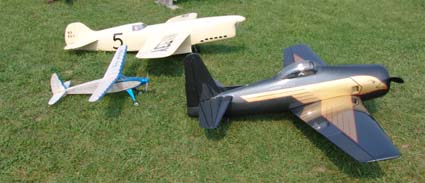
Keep in mind that the "little" Phantom Fury has a 48" wingspan.
That gives you an idea of the size of the Goon and Bearcat!
Return to "What's In This Issue"
September 28 PMAC Impromptu Fly-in
By Ken Myers
Flight Photos by Jim M (EFO member)
I received word from the Pontiac Miniature Aircraft Club (PMAC) that they were going to have an impromptu electric fly-in on Sunday, September 28 from 11 to 4 on Thursday, September 25 and sent out an email to all the EFO members. I told them that there would be FREE cider and donuts and the EFO turn out was HUGE! I hope that I can remember all the EFO members that were present. Here's who I remember seeing; Jack L., Jon Q., Chuck T., Paul S., Rick S., Roger W., Richard U., Hank W., Sterling S., Jim M., Tom B., Leon N., Danton B., Bob B., and me. That was 15 of us out of about the 35 pilots there. Nice going gang!
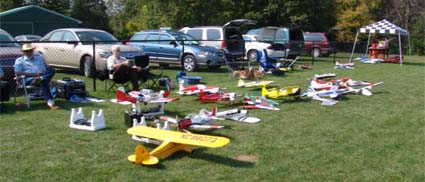
Some of the EFO planes at the north end
Sterling Smith did a good job of keeping everything under control and everyone had a lot of opportunity to fly. Sterling had ordered perfect weather with bright sunshine, mild fall temperatures and even had the wind blowing from the north, which is ideal for the layout of the PMAC field.

Danton's parkzone F4U Corsair on a fly-by
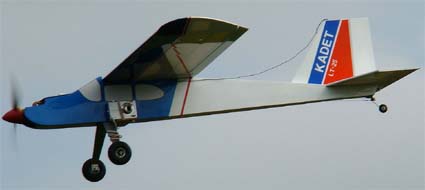
Richard's LT-25 Camera Plane at work
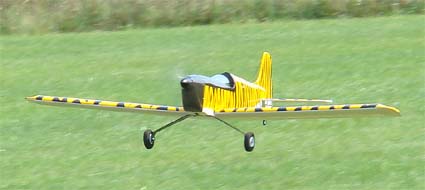
Roger's TigerKitten on Final
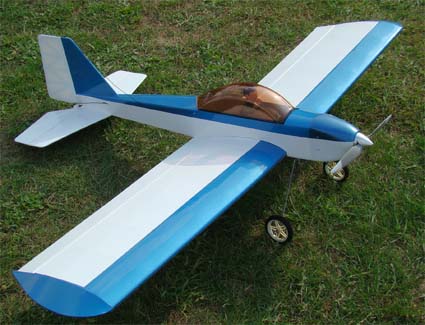
Jim's Switchback Senior waiting to take flight
I was extremely pleased with several things that happened while I was there.
I was very happy to see my old friend and EFO member Jack Lemon there. It had been way too long since I'd seen him at the flying field! Some of you "oldies" out there might recognize Jack's name if I mention Min-X radios.
I had a gentleman call me on Saturday evening to ask about electrically powered RC airplanes. His name is Steve W. and he's from "out state" a bit and can't find anyone to help him with electrics. He was visiting in this area, and I told him about the get together on Sunday. He showed up on Sunday and I took him for a walk down the flight line describing the planes and their performance and showing him his options from small foamie 3-D types to Tom's HUGE P-38. Many of the EFO members took Steve under their wing and shared their thoughts about e-power with him. Thanks again guys! Finally, I had a chance to take Steve up on the buddy box with my parkzone T-28. I believe we now have a convert to send into the wilds of Michigan! :-)
Finally, for me, it was a most gratifying day of flying. At the PMAC field in August, for their Annual Electric Fly, IĠd had a terrible day. I had a glitch with the supplied receiver in the parkzone T-28 and upon landing, tore out the one of the main gear. That was followed by hooking up the ailerons incorrectly in the Son of Swallow and dorking it in. Yuck!
The first thing that happened to me when I got to the field was that Sterling wanted me fly his "60-size" Stick. That showed a lot of confidence on his part! I flew it, had a ball with his really nice flying plane and I was feeling good! The best part was that everything continued to go very well with my flying all day long. I am sure my students, who were there to fly as well, were really happy about that!
Near the end of our time there, there was a drawing for many fine Castle Creation's products. About 1/2 the registered pilots there went home with something really nice that they had not come with.
We sincerely thank Sterling Smith and the PMAC membership for having this great day of electric flying, and Castle Creations for making it that much sweeter.
Return to "What's In This Issue"
New Electric RC Plane from a New Company: the Retro e'Moth
From Mark Freeland Mark@Retro-RC.net
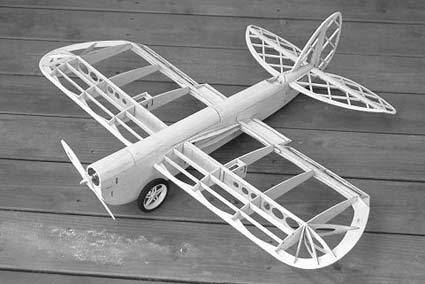
First, I must apologize to Mark. I actually met him at the Mid-Am this past summer. I noticed him assembling his really neat looking plane and walked over and talked with him about it. He told me that he was kitting it and showed me its features. He also gave me his business card, which I promptly left on my dresser and was only prompted to remember when he sent me the following email. Thanks for the memory jogger Mark! KM
Dear Ken,
Let me introduce myself. My name is Mark Freeland. I have been modeling for over 40 years now. Recently, after retiring from Ford Motor Co., I started my own company to design and manufacture kits for RC electrics. I have been actively modeling in the Detroit area since 1994 when I joined the Livonia Rib Crackers.
I recently launched my first kit offering, the Retro e'Moth.
The kit sells for $80. This does not include sales tax or shipping which would be extra. I ship via USPS Priority mail, cost depending on location, but about $6.00 locally. I will accept credit cards at the web site or over the phone.
I was hoping that you might add a link to my web site RetroRC.us.com in the Electric Flyers Only Web site.
Please feel free to call me or email if you have any questions.
Kind Regards,
Mark Freeland
Retro RC
PO box 193
Keego Harbor, MI 48320
www.RetroRC.us.com
Tel. (248) 212-9666
email: Mark@Retro-RC.net
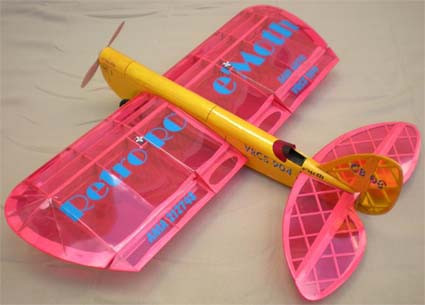 Return to "What's In This Issue"
Return to "What's In This Issue"
A Sort of Ercoupe
From Jim Breeya jbreeyea@uvm.edu
Jim sent me an email that said in part, "I have created a plane I call the E-coupe and it looks very close to the Ercoupe. It is park flyer size. I've noticed that there were people looking for an Ercoupe (other than 1/3 size) electric and small. I could send you a picture if you are interested in commenting on it." I did just that, and here is the information that he replied with. KM
Hi Ken,
Here is a photo of my E-coupe I took this afternoon just after a flight. I am just about done with trimming and decided to not use a flat bottom wing. I'm going to put a semi-symmetrical wing on it. It's very touchy in the wind. It has an 8x3.8SF prop and a three cell Li-Po. I can't remember the motor size, Hacker 20 something I think.
The body was from a foam biplane I trashed, the wing is from a pusher ultra-lite. The tail end is my doing. It has ailerons and elevator. There is no rudder or steering on the nose wheel.
I flew it in good crosswind today and it would have been handy to have rudder, but it handled okay if you approached it right. The motor will pull it vertical but most of the time it flies at less than half throttle. It takes off grass no with no problem. It has a very short take off roll.
I know the cockpit isn't right but I'm leaving that to last.
Cheers,
Jim
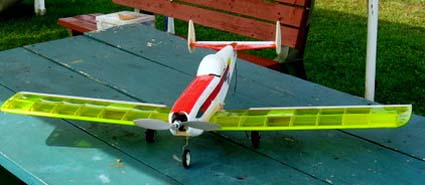
Okay folks. Go forth and be creative! Nice job Jim. KM
Return to "What's In This Issue"
TU-95 (follow-up)
From George Maiorana georgegpm@comcast.net
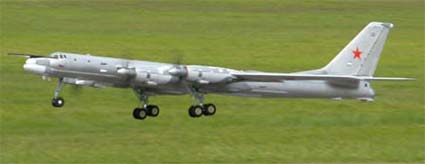
I received the following from George. KM
Hi All,
Of Interest. There has been posted on the NASA (National Association of Scale Aeromodelers) Web site www.nasascale.org/projects.htm some hi-res video of the Bear's first flights. Click on Tu-95 follow-up.
Enjoy,
George
Return to "What's In This Issue"
Jim Cross' AF Porterfield Collegiate
From Jim Cross (EFO member) jcross0243@sbcglobal.net
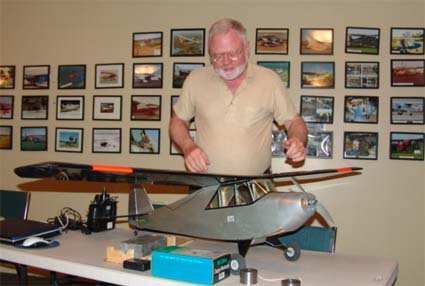
Hi Ken,
Bill Brown and I were at the Midwest club field this afternoon. The weather was perfect with an almost West wind of 6 to 9 MPH.
Bill flew my Porterfield while I observed and monitored the Eagle Tree Flight recorder "Seagull dashboard".
The readout displayed:
1. the motor RPM
2. propeller RPM (computed using the gear ratio)
3. motor voltage
4. motor current
5. motor temperature
6. Air speed
7. Altitude
8. Receiver Pack voltage
When I returned home, I downloaded the stored data into my PC and began to analyze it.
I found those A123 M1 cells to be incredibly consistent:
1. Pack voltage before takeoff = 19.84 Vdc at 74.9-deg F (Ambient)
2. Peak motor current at WOT during take-off (~ 15 seconds) = 22.13 Amps
3. Pack Voltage at end of WOT during take-off = 17.33 Vdc
4. Pack Voltage during the remainder of the 6.5 minute flight at ~ half throttle = 18.56 to 18.83 Vdc
(The flight recorder reports motor current at ~7.5 Amps but that's based on digital sampling of a digital wave form so I'm dubious of the accuracy)
That's the kind of voltage stability one expects of a power supply but not a battery! Those M1 cells are remarkable.
Recharging the M1 cells upon returning home only took 898mAH of charge to reach 3.6 volts/cell.
Additionally, my Porterfield weighs only 76.8 oz. compared to Bill's Porterfield, which tipped the scales at 108.9 oz. We're using identical motors (older Astro 6625G), the main difference is I use 6 x M1 cells, while he was using 14 x 2400 mAh C sized NiCads.
Thanks for all your input on the M1 cells.
Jim
Return to "What's In This Issue"
MIDWEST R/C SOCIETY
20th annual
R/C SWAP MEET
Sunday, November 9th, 2008
9:00 a.m. to 1:00 p.m.
Location
Northville Senior Community Center
Northville, Michigan
Admission Charge
$5.00 per person
(kids under 12 and women are FREE)
Vendor Table Cost
$20.00-$25.00 per table, depending on location
The vendor table cost includes two admissions.
Vendor set up time is 8:00 a.m.
Advance table reservations are highly recommended, last year all tables were sold in advance!
For information, call Rudi Reinhard at 248.643.4509
or e-mail: wwtbi@aol.com
Directions
Take the 8 Mile Road exit off of I-275 and go west for 2.5 miles on 8 Mile to Center Street.
Go south (left) on Center Street for .5 miles and then west (right) on Main Street.
The Northville Senior Community Center is located at 303 Main Street in downtown Northville.
There is free parking in the back of the building, off of Cady Street.
This is always the largest and best swap meet in southeastern Michigan!
Return to "What's In This Issue"
EFO Membership 2009: Special Notice!
From Ken Myers, President
If you are already a member of the Midwest RC Society and rejoin Midwest for 2009, your dues to the EFO for 2009 will be FREE. I will cover it, as I fully expect to be elected as an officer at Midwest once again. As an officer, I do not pay dues to Midwest, so it will be my way of helping both clubs.
If you would like to become an EFO member AND a Midwest member, you can save $70 by joining Midwest at the Midwest Swap Meet on November 9 in Northville. Midwest is waving the $50 initiation for THAT ONE DAY. Anyone joining Midwest on that day will only pay the $100 annual membership dues. Your membership to Midwest for 2009 also includes membership in Midwest for the rest of this year. Also, I will pay the $20 annual dues to the EFO for you for 2009.
AMA membership is required to join both clubs.
Many of you have flown at the Midwest 7 Mile Rd. field. You know what a truly great facility it is. The current members of Midwest would love to see this great field used more and is actively seeking new members. Please fully consider the benefits of joining both Midwest and the EFO. 2009 couldn't be a better time!
If you'd like to join Midwest, but cannot attend the Swap Meet on November 9, please contact me before that date and we'll make arrangements for you to "join on that day."
EFO dues for non-Midwest members remain at $20 for 2009.
Return to "What's In This Issue"
Dave Stacer's Electro Flying Fusion Takes to the Air!
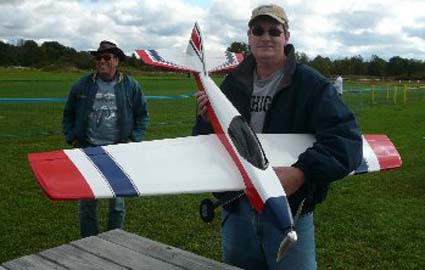
Dave with his Fusion after the maiden
On Saturday, October 4, at the very well attended EFO flying meeting, Dave's Fusion took to the air and flew GREAT! Ken flew the initial trim flight with Dave beaming the whole time. Since Keith was there, he took it up and flew every possible maneuver that this great sport plane is capable of. What a flight. Dave did several more flights with HIS new plane and was pleased that he persevered through the construction of this true builder's kit.
It came out at exactly 80 oz., which gives this 569 sq.in. plane a cubic wing loading of 10.2 oz./cu.ft., which is typically an advanced sport plane. The plane's power system includes the Scorpion S-4020-12, BP Hobbies 70-amp Opto ESC, a split pack (3x2) 6S1P "A123" 2300mAh pack and an APC 12x10E prop. That is one very winning combination.
Initial takeoff video at: Link removed
Return to "What's In This Issue"
| 




















